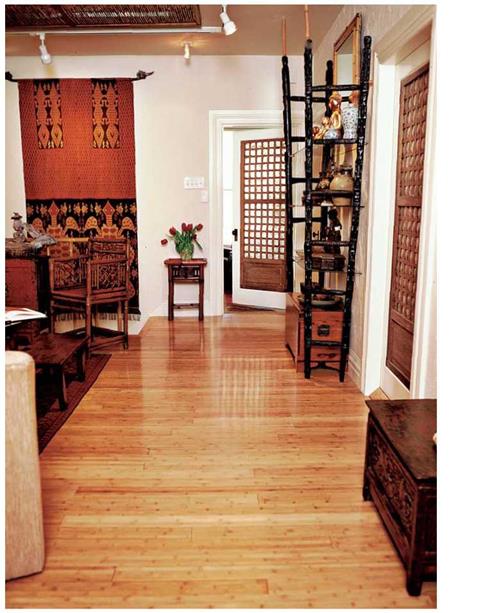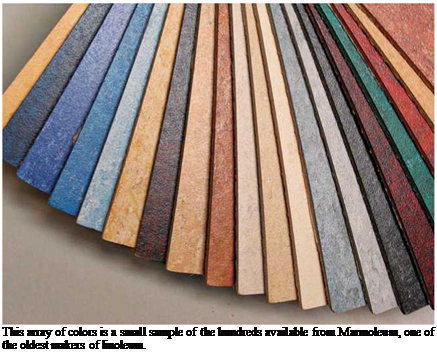OTHER NATURAL FLOORINGS
The materials in this group—bamboo, coconut palm, and cork—are engineered to make them easier to install and more durable. And their beauty is 100 percent natural.
Bamboo flooring sounds implausible to people who visualize a floor as bumpy as corduroy. However, bamboo flooring is perfectly smooth.
It is first milled into strips and then reassembled as multi-ply, tongue-in-groove boards. Available in the same widths and lengths as conventional hardwood, bamboo boards are commonly 58 in. to 58 in. thick. Bamboo flooring can be nailed or glued. But if you glue it, allow the adhesive to become tacky first so the bamboo doesn’t absorb moisture from it.
Bamboo flooring comes prefinished or unfinished, and can be sanded and refinished as often as hardwood floors. It’s a warm, beautiful sur
face, with distinctive peppered patterns where shoots were attached. Bamboo is hard and durable, with roughly the same maintenance profile as any natural wood product, so you must vacuum or mop it regularly to reduce abrasion. Avoid installing it in chronically moist areas.
 Coconut palm flooring, like bamboo, is plentiful and can be sustainably harvested. Its texture is fine pored, reminiscent of mahogany. Because coconut palm is a dark wood, its color range is limited, from a rich, mahogany red to a deep brown. And it is tough stuff: Smith & Fong™ offers a %-in.-thick, three-ply, tongue-and-groove strip flooring, called Durapalm®, which it claims to be 25 percent harder than red oak. Durapalm is available unfinished or prefinished. One of the finish options contains space-age ceramic particles for an even tougher surface. So if you’re thinking of installing a ballroom floor in your bungalow, this is definitely a material to consider.
Coconut palm flooring, like bamboo, is plentiful and can be sustainably harvested. Its texture is fine pored, reminiscent of mahogany. Because coconut palm is a dark wood, its color range is limited, from a rich, mahogany red to a deep brown. And it is tough stuff: Smith & Fong™ offers a %-in.-thick, three-ply, tongue-and-groove strip flooring, called Durapalm®, which it claims to be 25 percent harder than red oak. Durapalm is available unfinished or prefinished. One of the finish options contains space-age ceramic particles for an even tougher surface. So if you’re thinking of installing a ballroom floor in your bungalow, this is definitely a material to consider.
Cork flooring is on the soft end of the hard-soft continuum. Soft underfoot, sound deadening, nonallergenic, and long lasting, cork is the ultimate “green” building material. Cork is the bark of the cork oak, which can be harvested every 10 years or 12 years without harming the tree (some cork trees live to be 500 years old). Traditionally sold as Мб-in. by 12-in. by 12-in. tiles, which are glued to a substrate, cork flooring now includes colorfully stained and prefinished squares and planks that interlock for less visible seams. Cork flexes, so many manufacturers use a flexible coating such as UV-cured acrylic to protect the surfaces and edges from water. Cork’s resilience comes from its 100 million air-filled cells per cubic inch; so it’s a naturally thirsty material. Wipe up spills immediately and avoid soaking a cork floor when mopping it: Damp mop instead and periodically refresh its finish.
Disadvantages: Avoid dragging heavy or sharp-edged objects across it, because it will abrade. Chair and table legs can leave permanent depressions.
Typically, engineered cork flooring has a three-ply, tongue-in-groove configuration. The surface layer is high-density cork, the middle layer is high-density fiberboard with precut edges that snap together, and the underlayment layer is low-density cork that cushions footsteps and absorbs sound. First developed in Europe, snap – together panels float above the substrate, so owners can easily replace damaged planks or, when it’s time to move, pack up the floor and take it with them. Many snap-together floors are glueless, but floors requiring glue usually need it to bond planks together, not to glue them to a substrate.

![]() Most engineered flooring is laminated to some degree, so here the term applies to a group of floorings whose surface layers are usually photographic images covered and protected by a clear melamine (plastic) layer. The photographic images often show wood grain, tile, or stone. Although plastic-laminate “wood” flooring may be a hard sell to traditionalists, the stuff wears like iron and every year captures a larger share of residential flooring. Moreover, as this category increases in popularity, manufacturers offer more and more colors and textures, including many that don’t mimic natural materials and are quite handsome on their own.
Most engineered flooring is laminated to some degree, so here the term applies to a group of floorings whose surface layers are usually photographic images covered and protected by a clear melamine (plastic) layer. The photographic images often show wood grain, tile, or stone. Although plastic-laminate “wood” flooring may be a hard sell to traditionalists, the stuff wears like iron and every year captures a larger share of residential flooring. Moreover, as this category increases in popularity, manufacturers offer more and more colors and textures, including many that don’t mimic natural materials and are quite handsome on their own.

![]()
 Developed and first adopted in Europe, laminate flooring is most commonly snap-together planks that float above a substrate, speeding installation, repairs, and removal. Of all flooring materials, laminate is probably the most affordable; and as noted, it’s almost indestructible. Because it resists scratches, chemicals, burns, and water, it’s a good choice for high-use or high – moisture areas. It’s also colorfast, dimensionally stable, and easy to clean—though many manufacturers insist that you use proprietary cleaning solutions. For a good overview of installing laminates, see www. armstrong. com.
Developed and first adopted in Europe, laminate flooring is most commonly snap-together planks that float above a substrate, speeding installation, repairs, and removal. Of all flooring materials, laminate is probably the most affordable; and as noted, it’s almost indestructible. Because it resists scratches, chemicals, burns, and water, it’s a good choice for high-use or high – moisture areas. It’s also colorfast, dimensionally stable, and easy to clean—though many manufacturers insist that you use proprietary cleaning solutions. For a good overview of installing laminates, see www. armstrong. com.
Disadvantages: Laminate flooring dents, exposing a fiberboard core, and you can’t refinish it, although damaged planks can be replaced.






Leave a reply